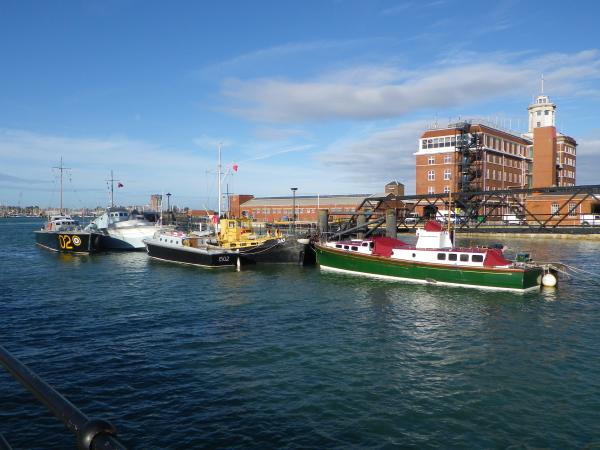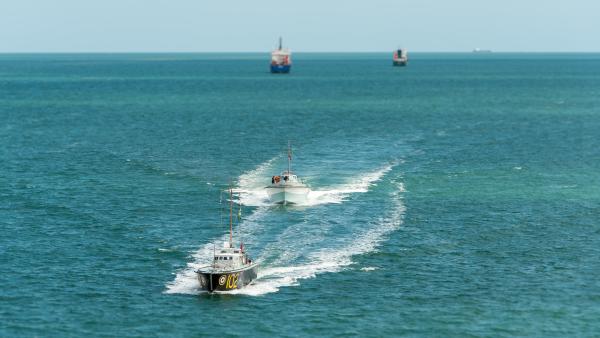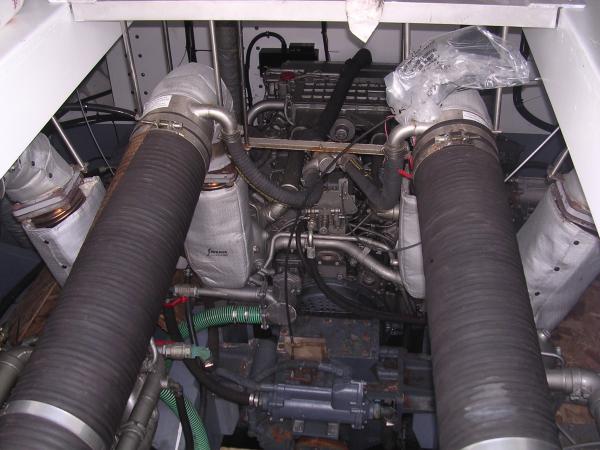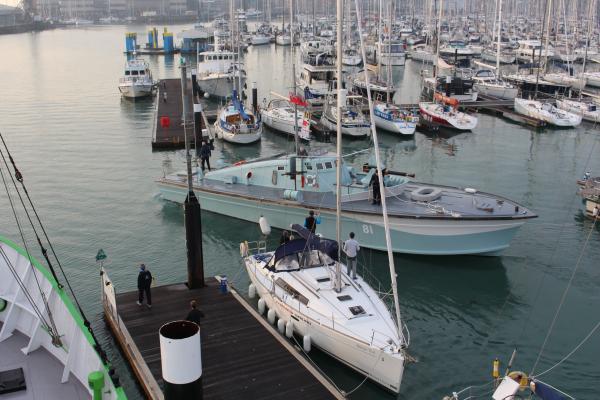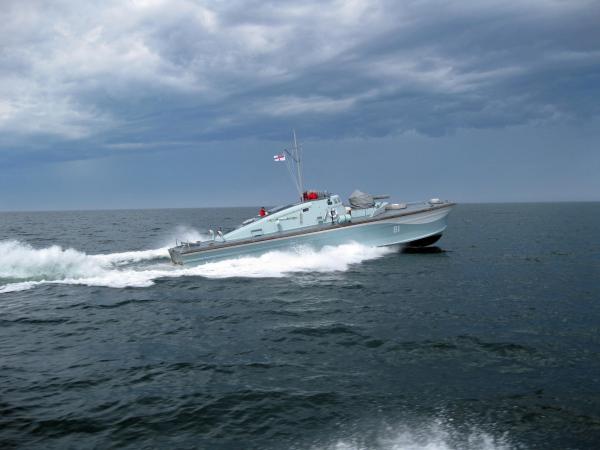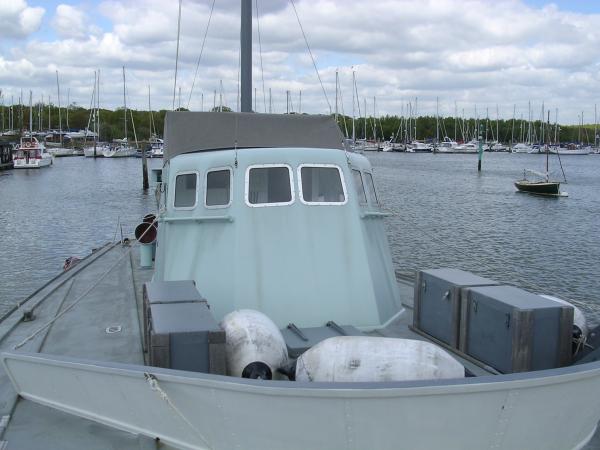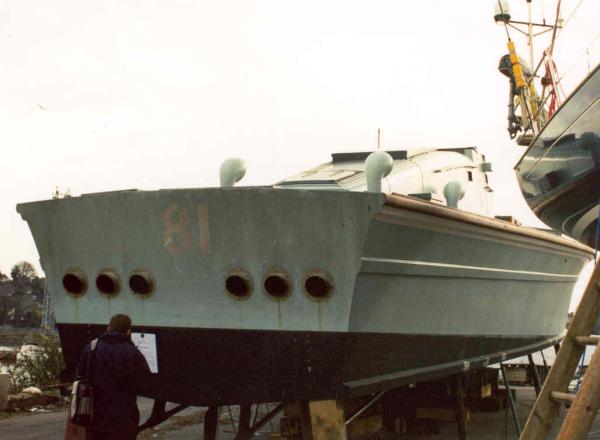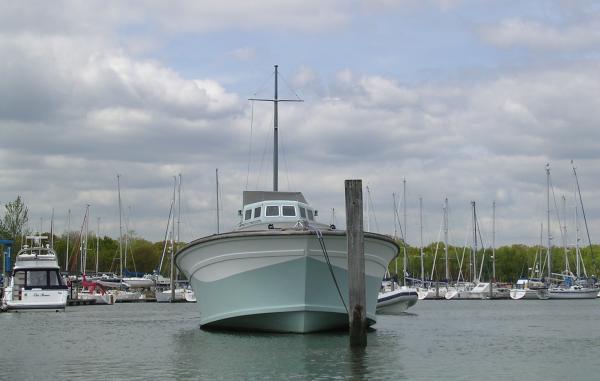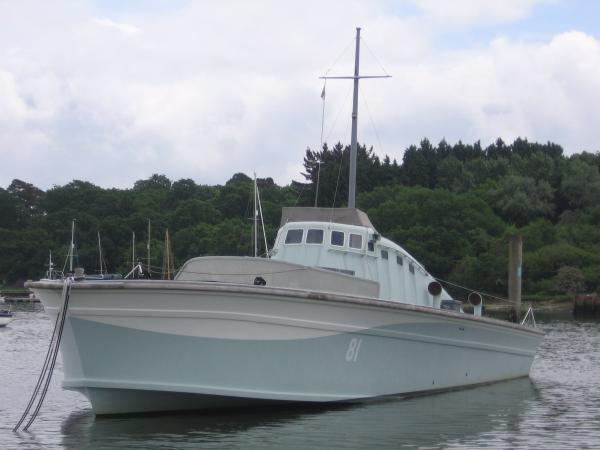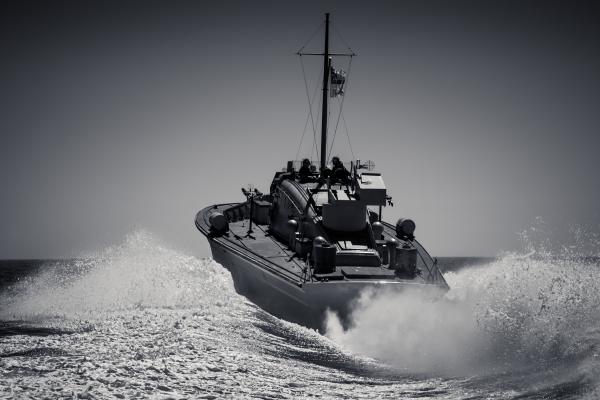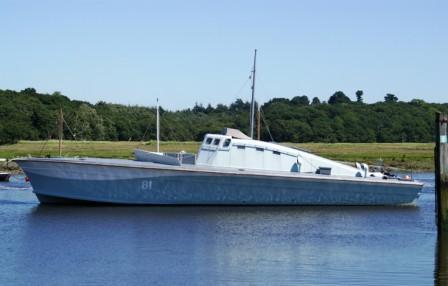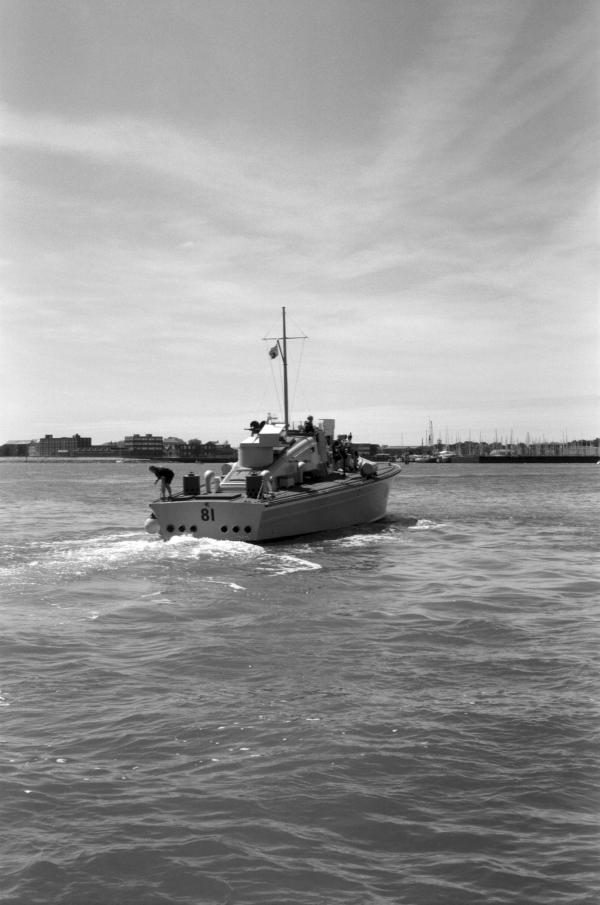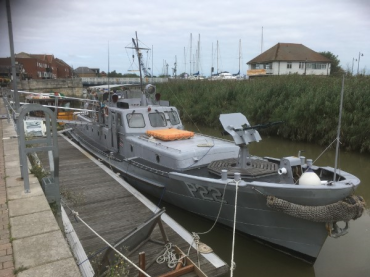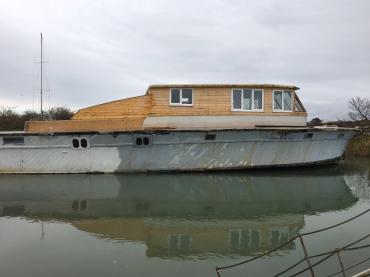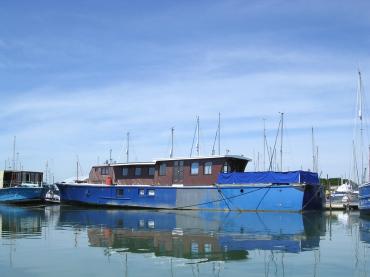

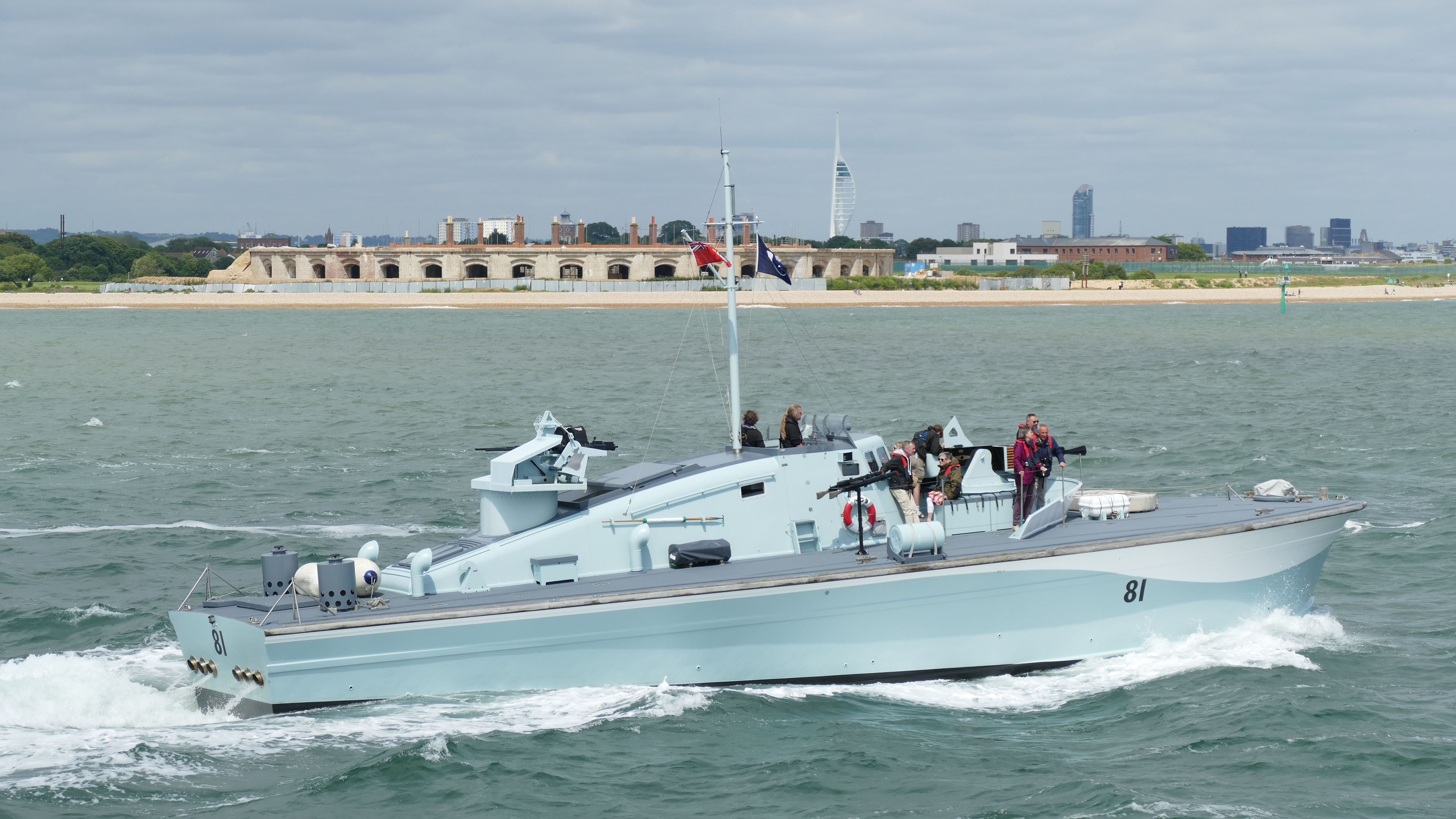
Previous names
- 1942 MGB 81
- 1943 MTB 416
- 1959 Jolly Roger
- 1964 Cresta
Details
Construction
Dimensions
History
MGB 81's design was produced by the British Power Boat Company (BPB) in collaboration with the Admiratly and, in all, 105 of her type were built (including some which were completed as motor torpedo boats). MGB 81 had a chine hull form using double-diagonal mahogany sides and a triple diagonal mahogany bottom. Although ordered on 27 November 1940, MGB 81 was not laid down until 16 December 1941. She was launched on 26 June 1942 and was by then virtually complete, for she was on trials on 8 July and achieved a speed of 38.63 knots on Southampton Water.
She was accepted and commissioned on 11 July 1942 and then worked up at HMS Bee, the coastal forces base at Weymouth, before joining the 8th MGB Flotilla at Dartmouth in August 1942. Between then and September 1943, MGB 81 was involved in six actions. Off Guernsey on the night of 13/14 August 1942, she engaged in a close-range gun attack on two enemy armed trawlers and one trawler was severely damaged. The next month, the flotilla moved to Felixstowe and MGB 81 was soon in action off the Hook of Holland on 14/15 September, when two enemy motor vessels were damaged by gunfire and four armed trawlers were hit, with no damage to the MGBs.
In another action off Holland on 2/3 October, four enemy armed trawlers were engaged, and one of the flotilla, MGB 78 was lost. On 27/28 February 1943, the MGBs fought the escorts of a German convoy off the Hook, resulting in the sinking of MGB 79, and damage to MGB 81 caused by a shell hitting the engine room. In April 1943, the flotilla returned to Darmouth, though MG 81 was refitting at Brightlingsea from 29 April to 20 May. In June 1943, she was damaged in collision with MGB 115 and was repaired by BPB at Poole. On 11-12 September, she again sustained damage when fired on by shore batteries at Cap la Hague and spent the rest of the month being repaired at BPB's Poole yard.
In late September 1943, the boat was renumbered MTB 416 and her designated armament was increased to reflect her new role, with the addition of two 18-inch torpedo tubes. Even though they were given the motor torpedo boat (MTB) classification, some of the former MGBs did not ship torpedo tubes, so it is not certain that MTB 416 was so fitted. Her flotilla became the 1st MTB Flotilla and redeployed to Ramsgate for a short period in October 1943 before returning to Dartmouth.
MTB 416 was refitted at Poole by BPB between 5 January and 2 March 1944. Her first recorded action as an MTB was in Lyme Bay on 21-22 April, when she engaged German E-boats and sustained action damage. Repairs were again made at Poole, but she was back in action for Normandy landings, where she was involved from 6 to 30 June 1944, with Gosport as her base.
On the night of 23/24 June, she was involved in an attack on a German convoy leaving Cherbourg. Although MTB 416 was only backing up this operation, one of her crew was killed. On the night of 18/19 July, she obtained hits on German R-boats off Cap d'Antifer, but her hull was damaged by gunfire and she returned to Poole again for repairs.
In September 1944, the flotilla's base changed to Lowestoft and her next action was on 14 February 1945 at Ostend. On 27 April 1945, with the war in Europe in its final days, she paid off at Poole and was placed in reserve. On 2 October 1845, MTB 416 was approved for disposal and was later sold.
Little is known about her subsequent history until 1958, when she was arrested by Customs officers at Shoreham whilst on a smuggling operation. She was sold on for use as a sailing school accommodation ship at Hardway, Gosport, and renamed JOLLY ROGER. In 1964, she was sold to become the houseboat CRESTA, also at Hardway.
In 1984, she was towed to Burlesdon on the River Hamble, and in 1988, was bought by Guy Webster to restore her to her wartime appearance. On 17 September 1998, she was bought by Philip Clabburn and was reconstructed at the British Military Powerboat Trust's Marchwood site between 1999 and 2002. Petrol engines were thought to be prohibitively expensive to run, so three 1,000-bhp V-12 MAN turbocharged diesel engines were fitted, giving an estimated top speed of 45 knots.
Since late 2009, MGB 81 has been based at Portsmouth, following her acquisition by the Portsmouth Naval Base Property Trust. Source: Paul Brown, Historic Ships The Survivors (Amberley, 2010), updated Mar 2011.
Significance
What is the vessel’s ability to demonstrate history in her physical fabric?
Although MGB 81 has undergone substantial restoration, with the decking, deckhouse and much of the internal fittings having been replaced, much of her hull is original. Only limited planking was replaced between 1988 and 2002, along with some of the longitudinal beams the lower beams of the frames in the forward half of the vessel in 2017/18. As such, the majority of her hull, the heart of the vessel, is original.
During the 1940s some 600 ‘short’ hard chine hull semi planing MTBs, MGBs and MA/SBs were constructed for Coastal Forces. At the end of 2019, only 24 of these were known to survive, all in various states of repair (including near derelict houseboats). This includes three fully restored boats (MA/SB 27, MTB 102 and MGB 81). 96 boats of the same design as MGB 81 were completed of which ten survived at the end of 2019. During their service, not one of the boats suffered from structural defects (except those caused by enemy action) and the design is considered to be one of the finest built during the war. Although the deck, deckhouse and furniture are not original, they follow the original designs and thus preserve the original appearance and layout of the boat. Only minor amendments have been made to the layout below decks.
MGB 81’s service is harder to specifically identify in her vessel fabric. A metal patch on the port side of the hull is often suggested to be part of a repair of battle damage, but this cannot be confirmed. The boat underwent substantial refits during her service where battle damage was repaired and her restorations will have similarly repaired any damage that affected the integrity of the hull. However, the hull itself is a survivor of the war and just because it no longer bears the scars of this conflict, it should not be considered to ‘show no evidence’.
What are the vessel’s associational links for which there is no physical evidence?
Likewise, being one of only three Coastal Forces hard chine boats from the war that still operates (to which must also be added HDML 1387, a well preserved examples of a motor launch that also served in Coastal Forces), MGB 81 serves as an important material link to Coastal Forces. As Coastal Forces as an independent division within the Royal Navy was abolished in the 1950s, all of the bases used have long since closed and with an ever dwindling number of veterans, it is the boats that serve as the most visible and material reminder of this important arm of service during the war. MGB 81 is one of very few remaining examples (of all types) from the time.
Owing to her service in the 8th MGB Flotilla, MGB 81 has a strong link to perhaps the most famous figure in Coastal Forces, Robert Hichens. The commander of the flotilla, Hichens is the most decorated officer in the history of the RNVR and, before his death in 1943, was instrumental in establishing the tactics used by MGBs again enemy S-boats. He spent time on board MGB 81 and may even have sailed on her on occasion.
It has been possible to extract an almost complete wartime history of MGB 81 from historical sources, detailing her various deployments and engagements with the enemy (which were numerous). As such she can be presented as a true heritage vessel – complete in both form and history.
How does the vessel’s shape or form combine and contribute to her function?
Whilst British Power Boat had built a number of MTBs and MA/SBs that were later converted to MGBs in the late 1930s and 1940, MGB 81 was amongst the first batch of vessels built by the firm specifically as a Motor Gun Boat. Evidence of the specific nature of her role is visible in a number of details incorporated by Selman, including longitudinal bulkheads in the forward part of the vessel to support a 1,100kg gun and the numerous frames, stringers and webs, combined with the hog sheer of the deck to strengthen the hull in rough weather. MGB 81 therefore serves as an excellent example of a Second World War Coastal Forces boat. She embodies the lessons of early hard chine hull experimentation in the 1930s and as such her hull serves as an exceptional illustration of wartime design and construction that has benefitted from operational experience in the first year of war.
Although the berth behind Boathouse 4 was not a Coastal Forces base in the war, Portsmouth Historic Dockyard, next to an active Royal Navy base, is a very appropriate setting for a vessel of her type and MGB 81 is presented in a military environment alongside vessels of a similar size and function. Equally, although now fitted with replica weapons, MGB 81 retains the complete appearance of a motor gun boat.
Key dates
-
1942
Built by the British Power Boat Co. as a Motor Gunboat
-
1942
After extensive trials, joined the 8th MGB Flotilla at Dartmouth
-
1942
Close range gun attack on two German armed trawlers off Guernsey
-
1943
After escorting minelayers, contacted a German convoy north of the Hook and engaged the escorts
-
1943
The 8th Flotilla again moved to Dartmouth and the vessel was refitted at Brightlingsea
-
1943
Damaged in a collision with MGB 115 and repairs carried out at BPB Poole. Later damaged in an engagement off Cap de La Hague and again repaired at BPB Poole
-
1943
Re-designated MTB 416 with two 18 inch torpedo tubes
-
1944
Refit at BPB Poole after which she vectored onto and engaged five E-Boats in Lyme Bay, suffering damage
-
1944
Took part in the D-Day landings and later attacked a German convoy leaving Cherbourg, during which an AB was killed
-
1944
Attacked enemy R-Boats off Cap d’Antifer in which the CO was wounded and the vessel damaged. Further repairs at BPB Poole followed by further action
-
1945
Approved to lay up in Category “C” Reserve at Poole, followed by final paying off
-
1945
Bought by Mr J Evans
-
1958
Arrested by HM Customs for smuggling and subsequently sold to a Gosport scrap dealer and used as an accommodation barge by a sailing school in Gosport under the name JOLLY ROGER
-
1964
Bought by Mr John Ould and fitted out as a houseboat named CRESTA
-
1980
Bought by Mr John Coker
-
1984
Bought by Mr John Pepperell and towed to a mooring on the River Hamble at Bursledon
-
1988
Bought by Mr Guy Webster for restoration to her wartime appearance
-
1988-1992
Restoration work carried out
-
1990s
Moved from her mooring at Bursledon to Crableck Marina, still on the River Hamble
-
1998
Bought by Mr Philip Clabburn for the British Military Power Boat Trust and lifted out of the water at Marchwood Military Port
-
1999-2002
Restored to original condition and fitted with three 1000hp MAN diesel engines
-
2010
Completed vessel bought for exhibition and display, based at the Portsmouth Historic Dockyard
Grants
-
2009
£580,000 was awarded by the National Memorial Heritage Fund to purchase HSL 102 and MGB 81
Sources
North, A J D, Royal Naval Coastal Forces, Almark Publications, 1972
World Ship Society British Armed Forces Small Craft Historical Society, Survivors Register, 1998
Classic Boat: Sea Trials for MGB81, February 2003
Classic Boat: Gunning a gunboat, September 2011
Classic Boat: Power and the Glory, February 2004
Hudson, Geoffrey, WSS Small Craft Group Journal: Motor Gun Boat (MGB) 81, pp68-75, December Volume 14, 1999
Own this vessel?
If you are the owner of this vessel and would like to provide more details or updated information, please contact info@nationalhistoricships.org.uk

